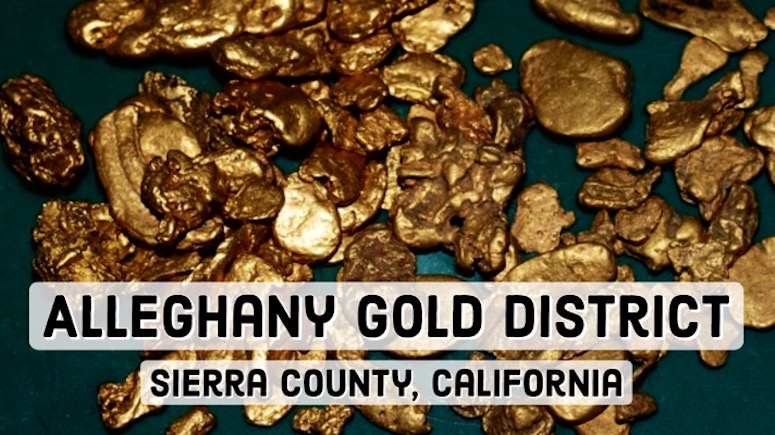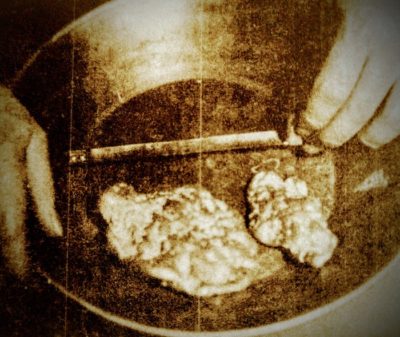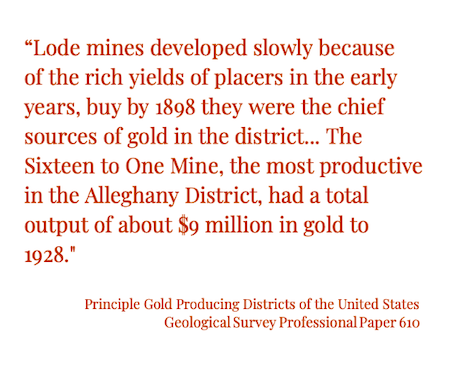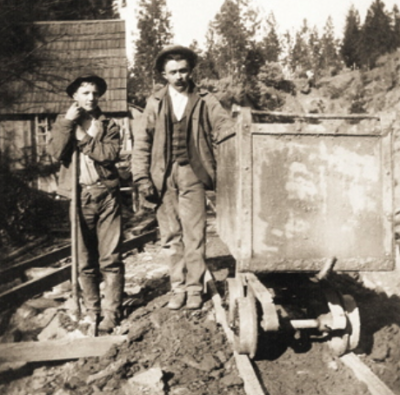
The Alleghany mining district has come to be known as one of the richest mining regions in California. The rich gold/quartz deposits were as extensive as anywhere in the world. There are active mines in the region even today.
The gold was found here within the first few years after the gold rush. Alleghany is located in southwest Sierra County, not far from Sierra City, Downieville, and many other camps along the Yuba River.
Placer Starts the Rush
The first miners to arrive had no idea that a network of rich quartz veins ran through this area. All the knew was that panning for gold in just about any creek in the area would result in gold… lots of gold! All of the creeks between the North and Middle Yuba Rivers would result in some nice nuggets.
Early on, particular interest was given to Kanaka Creek. Just a couple miles to the north, men set up a camp called Forest and worked the rich gravels of Oregon Creek.
The placer gravels were easily worked, but ancient river channels sitting high on the hill showed exceptional values as well. These were not easy to work manually, as the gravels needed to be moved down to the creek to process.
This was quickly remedied with the construction of several hydraulic mines. The biggest was at Chip’s Flat on the south side of Kanaka Creek. Another mile south was Minnesota Flat.
These mines worked old channel gravels from the Tertiary Yuba River. Now high above the present river, these ancient gravels were known to be exceptionally rich and also produce very large nuggets.
Drift mining was productive at many sites, and the most famous in the Alleghany would have to be the Ruby Mine. In the late 1930s, workers at the mine unearthed numerous fist-sized nuggets that would later go on display at the California State Fair.

Large Gold Nuggets recovered from the Ruby Drift Mine. Alleghany Mining District. Sierra County, CA. 1938.
Quartz Mining
Hard rock mining started almost as quickly as the miners arrived in Alleghany, but on a much smaller scale at first. While the quartz was clearly rich with gold, the early extraction methods were crude and challenging. Most miners found the hydraulic and drift mining operations to be much more productive in those early days.
With a few exceptions, most of the hard rock mining did not get going in earnest until after the turn of the century. The discovery of the Tightner vein in 1904 revived quartz mining in the region that lasted for decades.

Gold in this region is often quite pure, occurring in rich pockets of incredible density. Single ore bodies spanning just a few feet across have yielded gold that would today be valued in the millions of dollars. Sometimes gold runs closely with arsenopyrite, while in other locations the gold is clean with little other that quartz matrix.
The most famous of the mines in this region is the Sixteen-to-One Mine. This was not only the richest mine in Alleghany, but also one of the few mines that is still in operation today. Now it is also famous for producing some of the best “jewelry grade” specimens in the world. If you’ve ever seen a piece of jewelry with a cabochon of gold/quartz, there’s a pretty good chance it came from the Sixteen-to-One.
Other rich quartz mines in the district was the Brush Creek and Plumbago Mines. Though not nearly as extensive as the Sixteen-to-One, they each produced considerable gold.
The quartz veins were so rich and extensive in the Alleghany district, that it was one of the few areas in California that was still in operation following World War II, when depressed gold prices and logistical issues severely hampered mining efforts.

Alleghany Miners with Ore Cart. Late 1800s.
Small & Intermittent Mining Operations
The Alleghany district was well known for its large and long-lasting mining operations, but much of the total gold production is credited to smaller, exceptionally rich mines. Dozens of minor operations had outputs ranging from $50,000 to upwards of $1 million in gold, at a time when an ounce of gold was worth only $20.67 per ounce.

Many mines make up the Alleghany District. Most are now inactive and abandoned, but a few mining operations are still active in the region.
Modern prospectors still explore this area in search of gold, though on a scale that is only a tiny fraction of what once was.
I remember years ago when suction dredging was very active throughout the Mother Lode, and miners could pull good gold from the Yuba River and the streams that run through the Alleghany district. This mining methods is now banned in the state which has severely restricted the ability for the modern miner to make a living from gold.
Now most placer mining is done on an even smaller scale, using gold pans and sniping equipment to recover gold flakes and nuggets from down in the bedrock. It takes considerable effort to find paying quantities of gold, but it can certainly be done.
Others use metal detectors to scan the bedrock and listen for the faint signal of a gold nugget hidden underground.
Be aware that there is a mix of public lands (Forest Service) and private lands (patented mining claims) surrounding Alleghany. Even on the public land the best gold-bearing areas are heavily claimed. With the high price of gold (currently hovering above $1900 ozt.) there is a lot of interest in gold mining.
Despite the challenges, many miners are still extracting gold from this historically rich gold mining region.
Good Times & Gold Mines of Sierra City, CA
Early Spring Gold Prospecting in the Desert
Ancient Tertiary Rivers of Gold
